The photo strips created for the 1980s Eagle were the work of many – from the strip’s writers, the actors (and Fleetway staff) who featured in the strip, photographers… and those who were called on to provide some strips more specialist imagery, such as the spaceships that appeared in “Dan Dare” and “Doomlord”.
While Gary Compton was the “official” photographer on the “Doomlord” strip, Julian Baum was commissioned to create a number of model shots for the strip, and Isidro Campos caught up with him to ask him about his work on Eagle… a chat that led to a bit of a brainstorming of ideas for possible new takes on a certain alien assassin!
Julian Baum – Master of Marvels
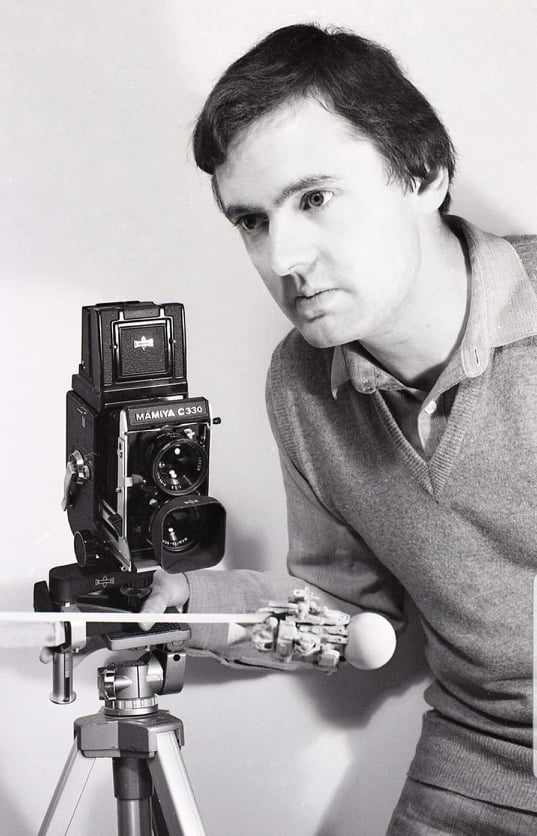
Today, Julian runs the long-established visual effects company Take 27 Ltd,, who produce space/astronomical art, science imagery in general, and archaeological reconstruction. A respected VFX artist and illustrator, his career began with building miniatures, photographing them, printing and cutting elements, and comping by photo-montage, adding airbrushed detail to the final piece. Much of his work was also space art, and diagrammatic illustration, for astronomy books.
Back in the 1980s, he created model shots featured in a “Dan Dare” story published in the issue of Eagle cover dated 20th April 1983, his impressive work covered in an extensive feature and interview with him in the 1985 Eagle Annual, which includes colour shots of his models, including a photo of Doomlord’s ship. It also appears that his photographs were provided to artist Ian Kennedy as reference for other fully-drawn episodes of the same story.
Isidro Campos: Julian, thanks very much for chatting with us about your work for Eagle. Can I ask, firstly, given Gary Compton was the “official” photographer of the “Doomlord” photostrip, did you have any contact with him, or did you work independently?
Julian Baum: I had no contact with Gary Compton, nor any involvement with the live-action Doomlord images. My briefs for images came as sentences in the script, which were highlighted by the art editor, I guess – don’t remember.
Everything I did was a miniature/FX shot, and at no time did it cross into Gary’s work. These days, it would, of course, but what we could do was fairly limited, and it was more about keeping continuity across the frames.
The images I did were sent to IPC, in the case of “Doomlord”, as black and white prints, and in the case of “Dan Dare” 6×6 transparencies.
Isidro Campos: Apart from the ship, you also made a Doomlords planet landscape, didn’t you?
Julian: Yes, that huge landscape I built! I remember it well and I’m still looking for those photos – honestly, there are thousands to go through. But, that landscape was built on a plywood board, about 5ft x 5ft. I formed the shapes, the hills and the crater, from cardboard formers, then applied ModRoc – bandage soaked in plaster of Paris – a standard model-making resource back in the day; maybe still is. I then added a fine layer of plaster, once the ModRoc had set. I left the natural colour of the plaster. Set up a single studio lamp, probably a 200W photoflood, and photographed the landscape against some black velvet.
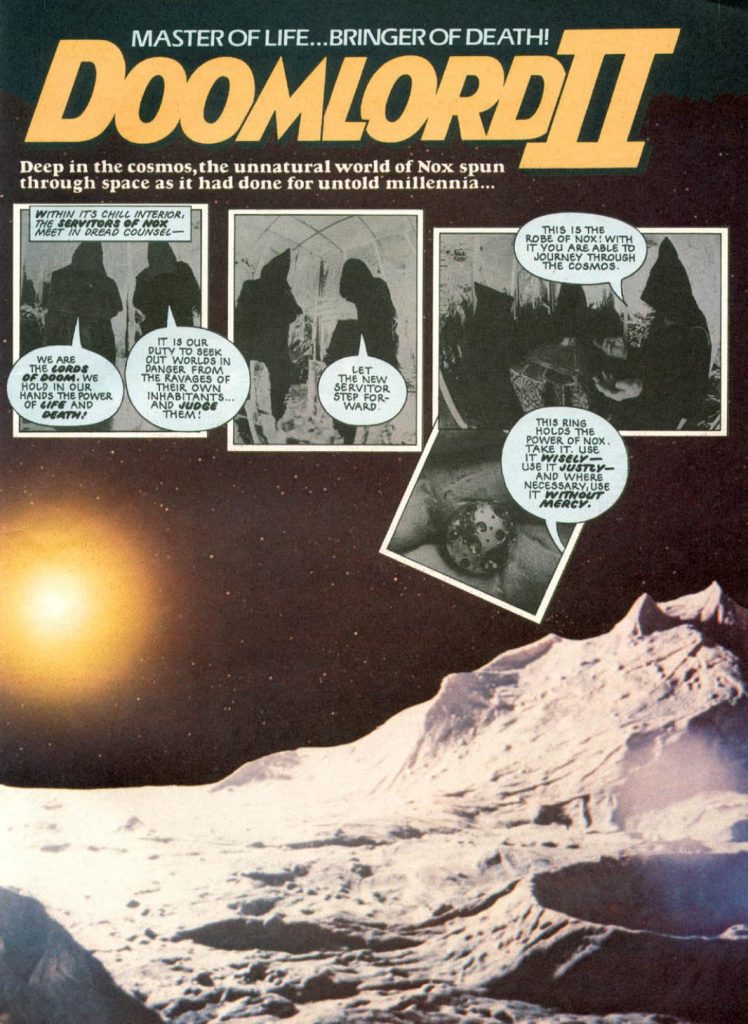
I used a Mamiya twin-lens reflex camera for this work, with a parallax mount to allow for the offset of the viewing lens and the taking lens. I then set the camera up in front of a sheet of glass, and taped to that was a sheet of black sugar paper with a circular hole cut into it, with two or three layers of tracing paper behind. Behind the glass, I placed a desklamp with a coloured lamp – yellow. I had marked on the viewfinder plate, the position of the horizon of the landscape, so I knew where to position the sun in the image. I did an exposure of the sun, on the same frame as the landscape, and what you have is the end result.
Isidro Campos: Thanks for your detailed explanation, that little step by step guide to your process is a big lesson in old school model making and effects for me, and the result was really good! By the way, what really happened to the spaceship model?
Julian: The model was definitely thrown out, I’m afraid. But before I did, amongst others, I know I took some photos of it. It also got used in a simple picture I did for Liverpool Museum, in 1980. I have that somewhere too. But the model is long gone.
Isidro Campos: Interesting, why that museum?
Julian: I had worked there for a few months. The model was finished with for Eagle, I needed a ship, quickly, so used the model again.
At least, I think it was that model. I’m not sure now, thinking about it, although it was very similar.
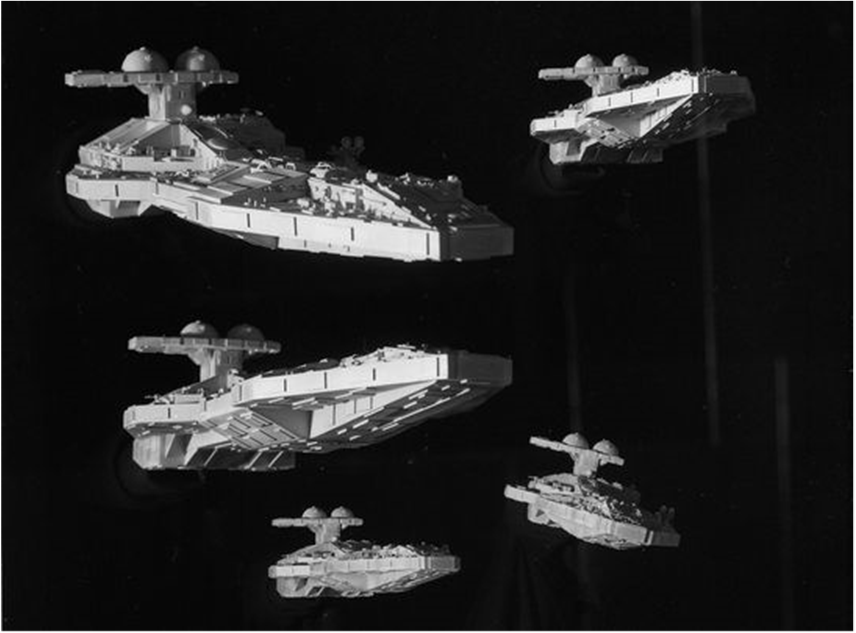
Isidro Campos: Did you keep the Dan Dare original transparencies and/or the actual models?
Julian: I do have some images, as it happens, of the solar sail ship set up. I came across those recently. I saw these sheets of negatives and have them on one side to sort out for you.
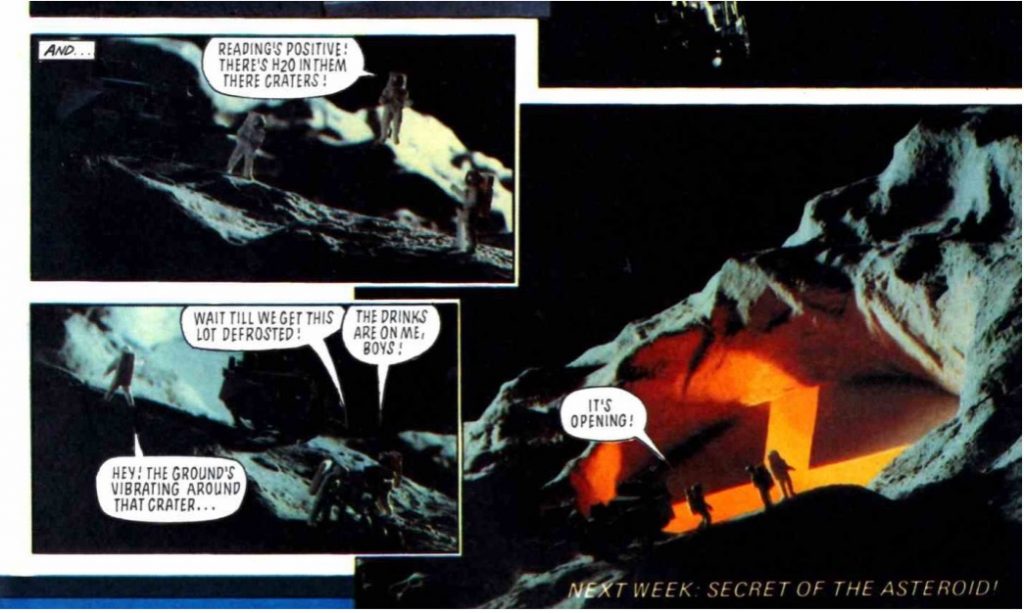
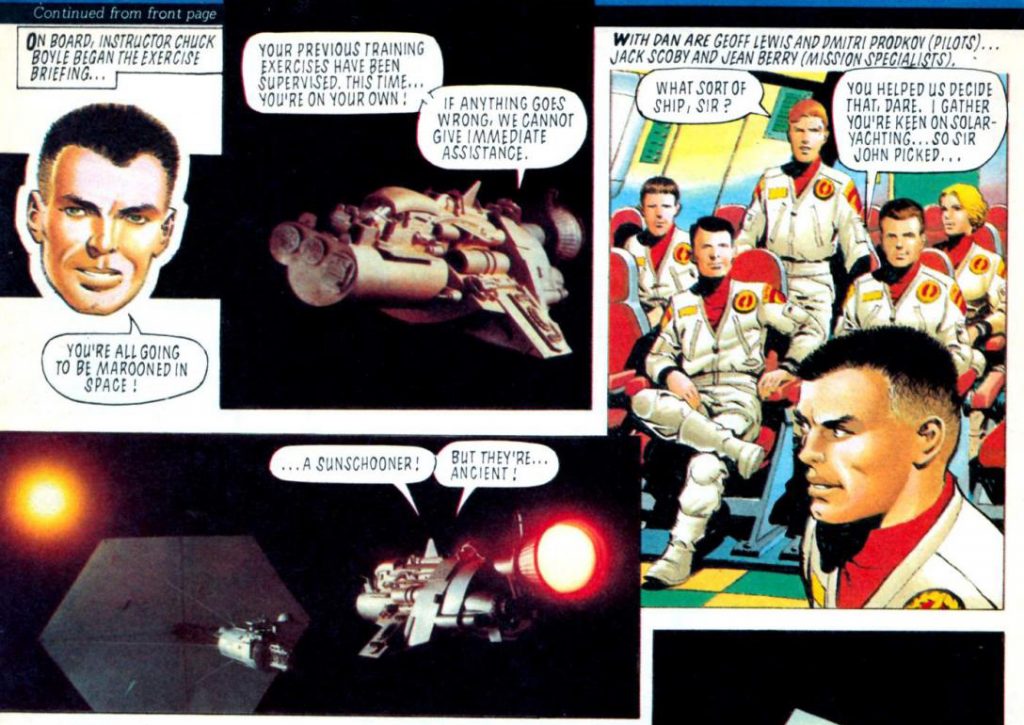
Isidro Campos: Thanks! I’m sure comics fans will enjoy seeing them. By the way, did you do any sketches before building all those ships, or you improvise? I mean, did you just use spare parts from here and there, or did you have a clear idea on mind?
Julian: I blocked out shapes to begin with, but generally improvised. I do the same now. My ‘sketching’ these days is done with major shape blocks in 3D, put together in multiple ways, and checked through a camera to see what works and what does not. I did a similar thing back then.
There wasn’t any particular direction from editorial at IPC, and I didn’t speak with the other artist on the Dan Dare strip, at least; only Pat Mills. But design was left to me. I doubt that would happen these days.
I found a box of negatives, some of which were what I was after. Others I cannot find, unfortunately. But at least the search has paid some dividends, including some of me in 1985, photographing a small scout ship model… another box of old photos has turned up which might just contain yet more. I’m going through them, in between other projects.
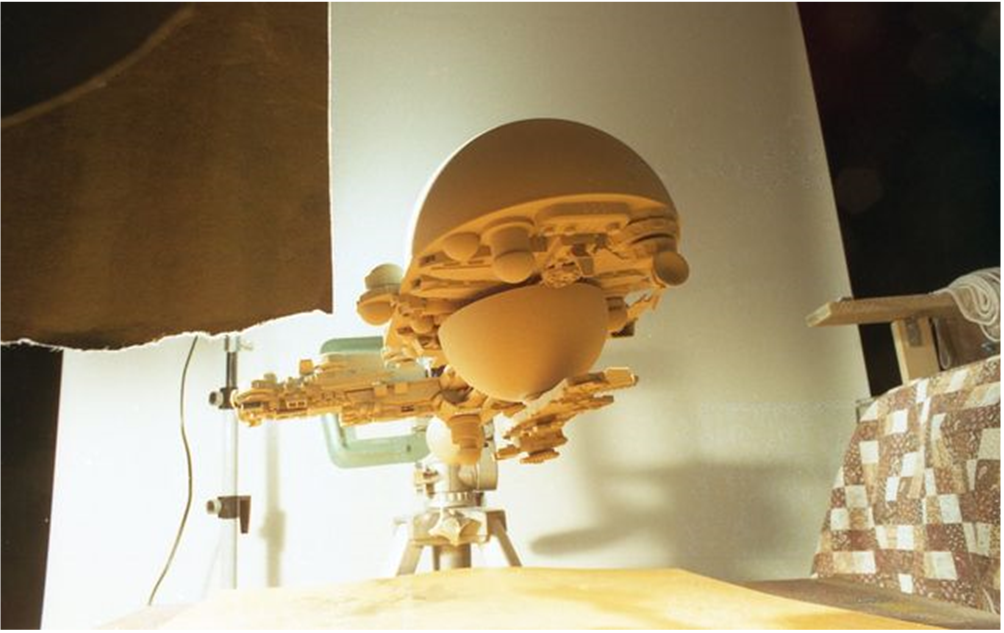
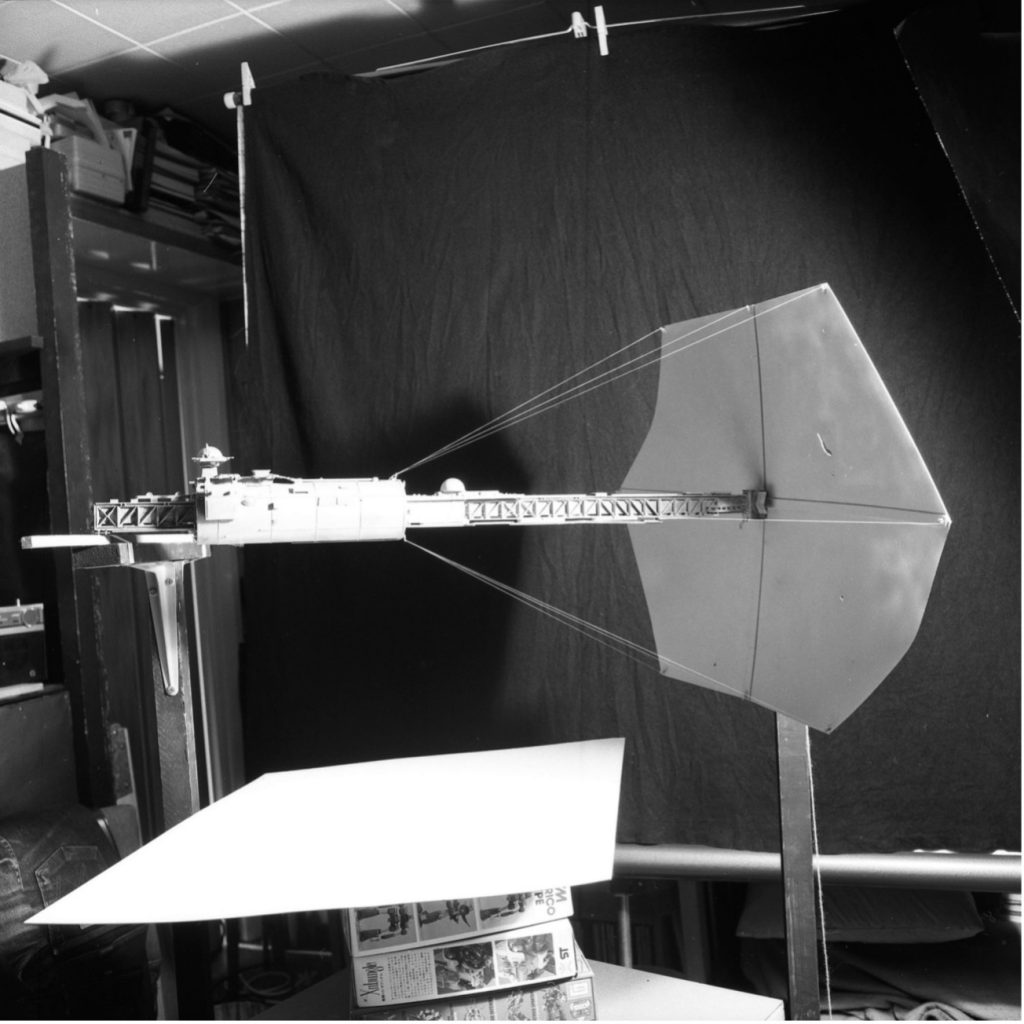

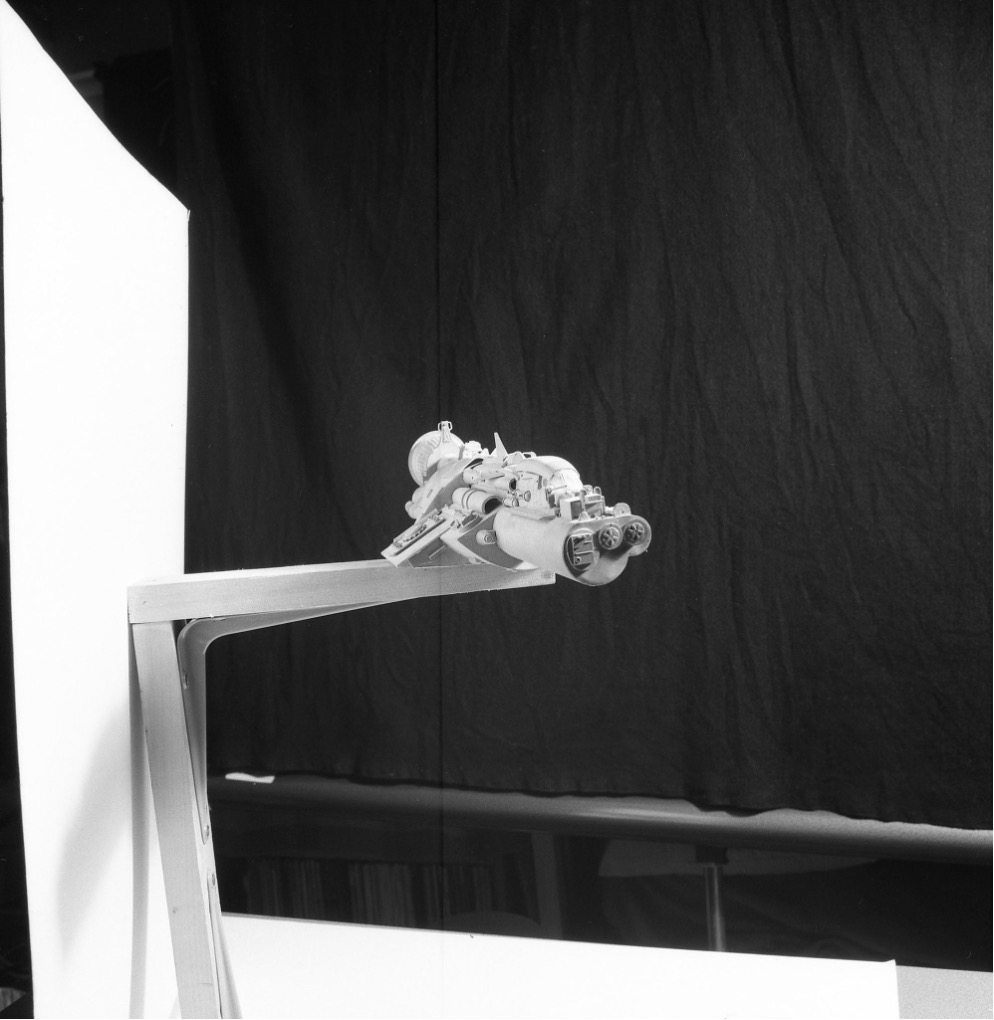
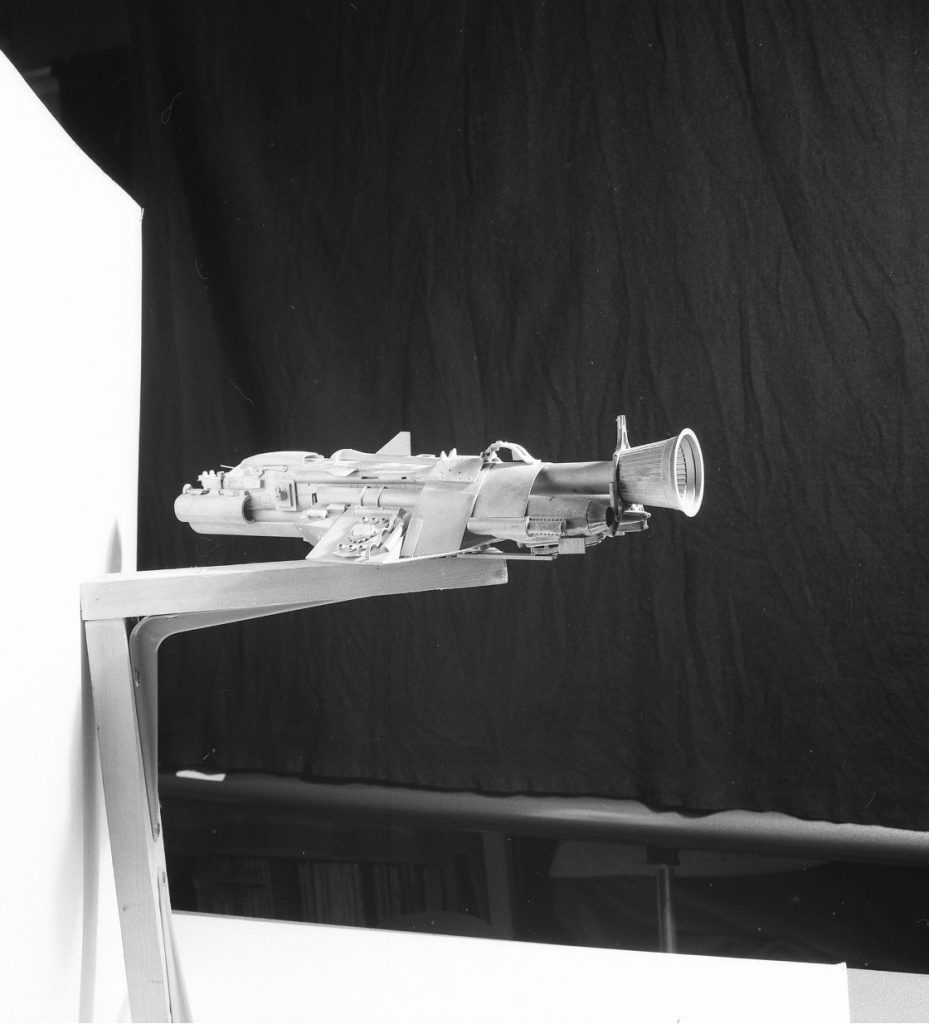
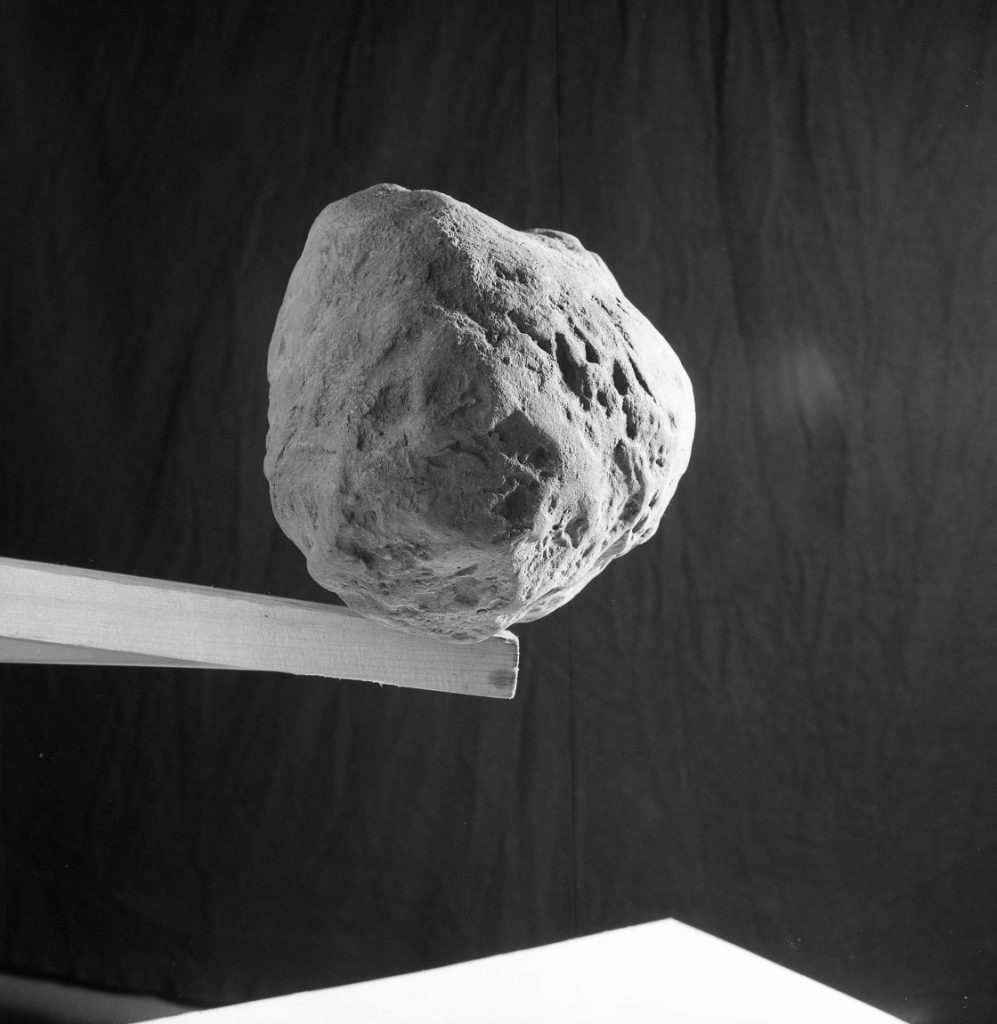

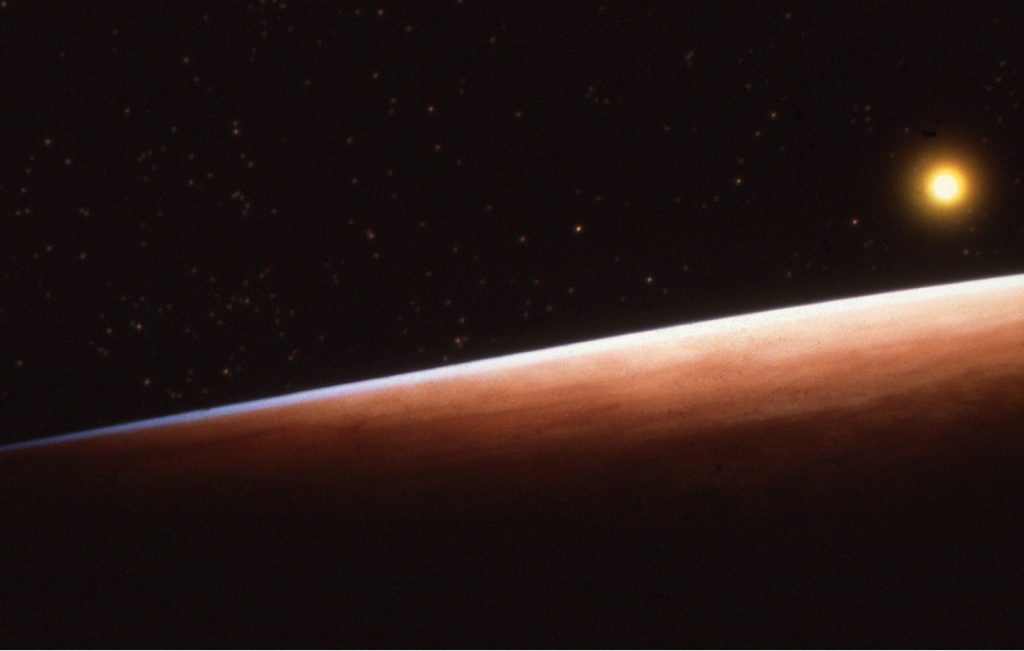
Isidro Campos: These are really awesome! I’d never have imagined those planets were boards. How was the sail made?
Julian: The sail was plastikard. A translucent material might have been better, with much more detail, but there was not the time. Generally I had one week maximum to do each issue.
Isidro Campos: Plastikard?
Julian: Those planet boards also were easily bent, slightly, to give a curved horizon. Plastikard was/is a trade name for sheet plastic, for modelling. It’s still available!
Isidro Campos: Wow, so the boards were originally made for this purpose?
Julian: The boards for the planets, you mean? Not specifically, they were just big sheets of mounting board that were pliable enough to get a nicer bend on them. I usually wedged the board between two buffers to force the bend.
I still use the same technique in CGI, but I can now get the correct curvature in all directions. But the principle is the same.
At this point in our interview, I revealed just how much Julian’s work had inspired me as an artist, and discussion took an entertaining turn as I showed him the faux Doomlord TV trailer I’d created, complete with 1982 copyright notice – which temporarily threw him… and we also talked about the masks I’d created, based on the original source mask for the Doomlord character…
Julian: Hmm – I had not seen that trailer. We really could do so much better …
Isidro Campos: Ha! I credited you in description. I spent three years on the making of this fake intro, and a lot of money, all down to my love of Doomlord, and everything that involves him. That low quality you mention was filmed that way purposedly. It had to look like that, like a cheap scifi Thames TV show with cheap effects like those used in the 1980s…
Julian: Ah – nice one! I did think it was likely yourself. I saw that credit!
Isidro Campos: The VHS resolution is real, not software made. I used a VHS player to record the final result into a VHS tape. Every single detail was meticulously reproduced, from the elaborate alien cloak to even the vintage British telephone shown. I inserted real 1982-83 London footage, and some from some shows of the time, into my shots.
Julian: Well, I am impressed, reading the about thinking and effort you put into it. It certainly has that look about it!
Isidro Campos: Even the soundtrack was entirely composed by my brother with that retro style and recorded in mono.
Julian: Very cool! Have you done more work like this, or do you intend to? You should.
Isidro Campos: No… After three years I got exhausted. Finding original masks, remaking your ship from the photostrip’s black and white pictures as a single reference, animating the faces of the actors, commissioning the different elements of the robe to several Taylors etc. The original robe was used by Peter Ustinov in the 1978 movie The Thief of Baghdad!
Julian: I had the model lying around for ages, in the old workshop. I think I mentioned that I cannot remember exactly what happened to it, and when. Suffce to say, had we been in contact years earlier, you could have had it.
Isidro Campos: That’d have been fabulous, what a dream…
Julian: It disappoints me that you do not have it. It cannot be helped – happens all the time, I guess. It would only have gone to the council tip; probably buried in landfill right now.
Isidro Campos: What a pity.
Julian: Although, oddly enough, your trailer is prompting me to do some Doomlord stuff. I haven’t thought about that for years, but I began to wonder what I could do now, with those same ideas, and discussions I had with the editor.
Isidro Campos: That sounds fantastic!
Julian: I’ll run stuff past you, see what you think.
Isidro Campos: Sure I’d love to! A Doomlord tribute revival, almost 40 years later!
Julian: Yes!
Isidro Campos: I also made these replicas of the famous mask from one of my originals…

Julian: These are really good!
Isidro Campos: I commissioned a master positive from a real one to make the ‘negative’ mould, so they’re exact duplicates.
Julian: Wow – very cool. That does look good.
Isidro Campos: Julian, thank you for your time talking to us about creating your Eagle work, so many years ago.
And here ends my first interview with Julian, a great artist of extraordinary kindness, who had the courtesy to answer my questions and provide wonderful material for all comic lovers, specially those passionate fans of Eagle of the 1980s.
Who knows? Maybe we’ll see an upcoming work from this brilliant man and Doomlord will once again take to the skies of London in his majestic spaceship, one of Julian Baum’s many creations. Thanks, my dear friend!
• Take 27 is online at www.take27.co.uk
• See Also: Behind the Scenes on Eagle: Secrets of Doomlord Revealed!
• If you’d like your own custom-made “Exterminus” mask, drop Isidro Campos a line via Facebook
• If anyone had a role in the Eagle photo strips, please do leave a comment below – please note, all initial comments made by someone new to this site are initially reviewed before publishing but are generally published automatically thereafter.
• Over on the Eagle Readers Facebook Group, Richard Pearce, Steve Winders, Shaqui Le Vesconte and others are attempting to identify the actors and Fleetway staff who featured in the photos strips, and identify locations, too. Do join in!
• Hibernia published a collection, Doomlord: The Deathlords of Nox in 2006, reprinting stories from Eagle published in issues cover dated 24th September 1983 – 3rd March 1984. Written by Alan Grant and John Wagner, illustrated by Heinzl, the 72-page collection includes an introduction by Alan Grant. Copies are still available on Comicsy
• Wikipedia has a detailed article on Doomlord
Dan Dare © 2021 Dan Dare Corporation | Doomlord created by Alan Grant and John Wagner
The founder of downthetubes, which he established in 1998. John works as a comics and magazine editor, writer, and on promotional work for the Lakes International Comic Art Festival. He is currently editor of Star Trek Explorer, published by Titan – his third tour of duty on the title originally titled Star Trek Magazine.
Working in British comics publishing since the 1980s, his credits include editor of titles such as Doctor Who Magazine, Babylon 5 Magazine, and more. He also edited the comics anthology STRIP Magazine and edited several audio comics for ROK Comics. He has also edited several comic collections, including volumes of “Charley’s War” and “Dan Dare”.
He’s the writer of “Pilgrim: Secrets and Lies” for B7 Comics; “Crucible”, a creator-owned project with 2000AD artist Smuzz; and “Death Duty” and “Skow Dogs” with Dave Hailwood.
Categories: British Comics, Comic Creator Interviews, Comics, Creating Comics, downthetubes Comics News, downthetubes News, Other Worlds, Science Fiction
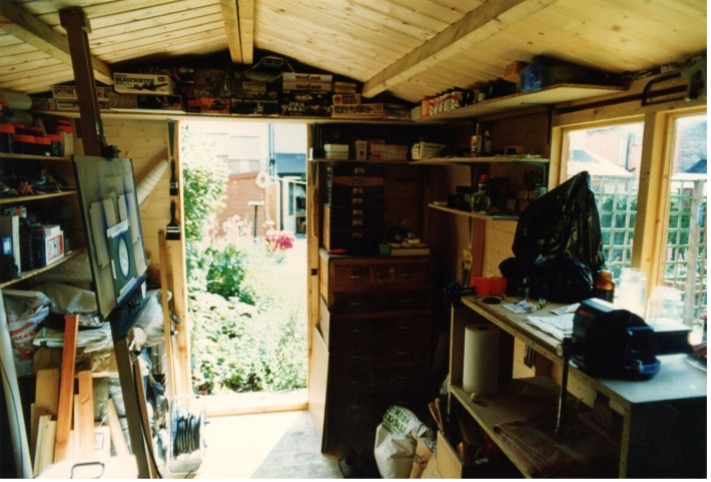
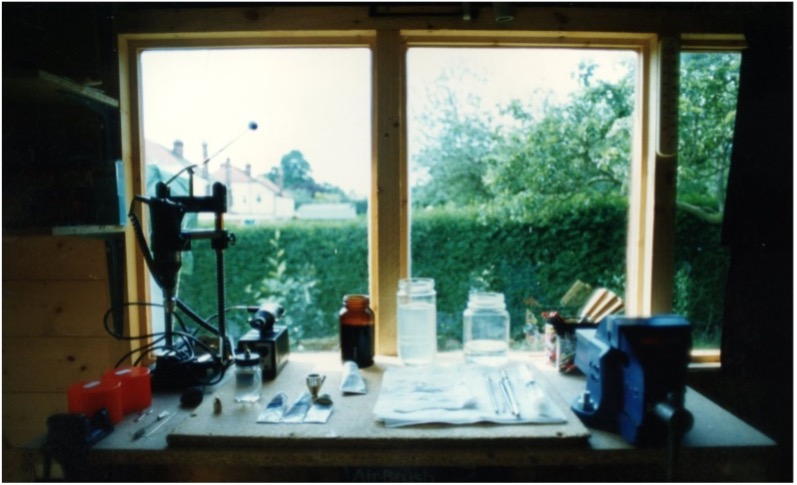
 Creating Comics: Cutaway Comics explores the greater Doctor Who universe
Creating Comics: Cutaway Comics explores the greater Doctor Who universe